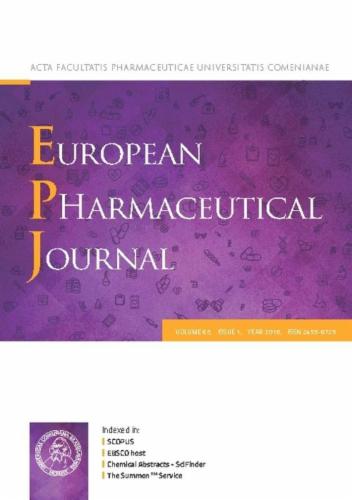Synthesis, transformations and biological evaluation of 5‑chloro-8-hydroxyquinoline hybrids
IF 4.3
3区 医学
Q1 PHARMACOLOGY & PHARMACY
引用次数: 0
Abstract
Taking in consideration of previous studies in the field of biological relevance and the chelating properties of derivatives bearing the hydroxyquinoline skeleton, establishing cationic centre by direct amidation as well as preparation compound with amino acid character was proposed. In order to test anticancer activity of the synthesised compounds, the applying of preliminary biological screening systems was planned. This concept is demonstrated in the context of the synthesis and transformation of a bifunctional glycine-type precursor substituted with 5‑chloro-8-hydroxyquinoline to hybrids with amino acid and amine feature. Stabilization of the precursor and formed amide composed of N,N-dimethylethylamine via partially aromatic ortho-quinone methide intermediate was tested with different cyclic imines in [4 + 2] cycloaddition. In these [4 + 2] cycloaddition reactions, 1H NMR analysis of the crude reaction mixture proved the formation of a single product in all cases. The relative configuration of the two newly formed stereogenic centres was determined by 2D-NMR technique. Compared to the precursor, all new derivatives exhibited less potent anticancer activity. Based on biological evaluations, out of the synthesized compounds the derivative with amino acid feature and some amidated derivatives showed toxic activity against the Colo 205 cell line.

5 -氯-8-羟基喹啉杂化物的合成、转化及生物学评价
考虑到生物相关领域的研究和羟基喹啉骨架衍生物的螯合性质,提出了直接酰胺化建立阳离子中心和制备具有氨基酸特征的化合物的方法。为了测试合成的化合物的抗癌活性,计划应用初步的生物筛选系统。这一概念在由5 -氯-8-羟基喹啉取代的双功能甘氨酸型前体合成和转化为具有氨基酸和胺特征的杂合体的背景下得到了证明。在[4 + 2]环加成中,用不同的环亚胺对N,N-二甲基乙胺前驱体和N,N-二甲基乙胺合成酰胺的稳定性进行了测试。在这些[4 + 2]环加成反应中,粗反应混合物的1H NMR分析证明在所有情况下都形成了单一产物。用二维核磁共振技术确定了两个新形成的立体中心的相对构型。与前体相比,所有新的衍生物都表现出较弱的抗癌活性。经生物学评价,合成的化合物中具有氨基酸特征的衍生物和部分修饰衍生物对Colo 205细胞株显示出毒性活性。
本文章由计算机程序翻译,如有差异,请以英文原文为准。
求助全文
约1分钟内获得全文
求助全文
来源期刊
CiteScore
9.60
自引率
2.20%
发文量
248
审稿时长
50 days
期刊介绍:
The journal publishes research articles, review articles and scientific commentaries on all aspects of the pharmaceutical sciences with emphasis on conceptual novelty and scientific quality. The Editors welcome articles in this multidisciplinary field, with a focus on topics relevant for drug discovery and development.
More specifically, the Journal publishes reports on medicinal chemistry, pharmacology, drug absorption and metabolism, pharmacokinetics and pharmacodynamics, pharmaceutical and biomedical analysis, drug delivery (including gene delivery), drug targeting, pharmaceutical technology, pharmaceutical biotechnology and clinical drug evaluation. The journal will typically not give priority to manuscripts focusing primarily on organic synthesis, natural products, adaptation of analytical approaches, or discussions pertaining to drug policy making.
Scientific commentaries and review articles are generally by invitation only or by consent of the Editors. Proceedings of scientific meetings may be published as special issues or supplements to the Journal.

 求助内容:
求助内容: 应助结果提醒方式:
应助结果提醒方式:


